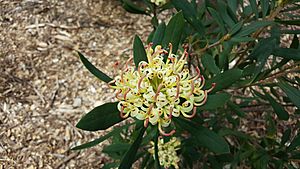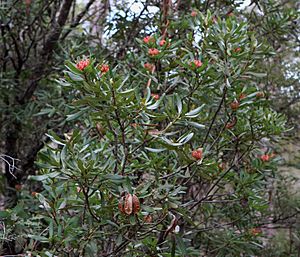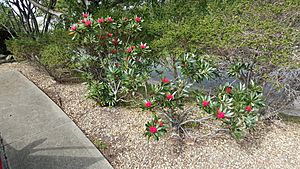Tasmanian waratah facts for kids
Quick facts for kids Tasmanian waratah |
|
|---|---|
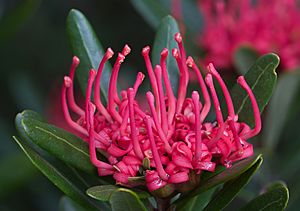 |
|
| Scientific classification | |
| Genus: |
Telopea
|
| Species: |
truncata
|
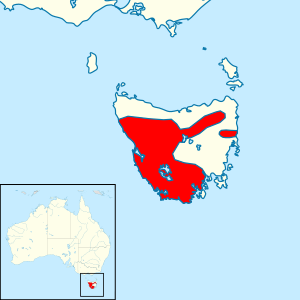 |
|
| Distribution of Tasmanian waratah | |
| Synonyms | |
|
|
The Tasmanian waratah (Telopea truncata) is a special plant. It belongs to the Proteaceae family. This plant is found only in Tasmania. It grows in wet, acidic soils. You can find it at high places, from 600 to 1200 meters (2000–4000 feet) up.
The Tasmanian waratah lives in different forest types. These include alpine Eucalyptus forests, rainforests, and scrublands. It usually grows as a shrub with many stems. It can reach about 3 meters (10 feet) tall. Sometimes, it grows into a small tree, up to 10 meters (35 feet) high.
Its bright red inflorescences, or flower heads, appear in the Tasmanian summer. This is from November to February. Each flower head has 10 to 35 individual flowers. You might sometimes see yellow-flowered plants. These are just a color variation, not a different type of waratah.
A French botanist named Jacques Labillardière first collected this plant in 1792–93. Scientists officially described it in 1805. Studies show the Tasmanian waratah is unique among the five waratah species. You can grow it in temperate climates. It needs soil that drains well and stays moist. It likes sunny or partly shaded spots. There are also some special types of waratahs you can buy. These are hybrids (mixes) of the Tasmanian waratah with other waratah species. These include the New South Wales waratah (T. speciosissima) and the Gippsland waratah (T. oreades).
Contents
What Does the Tasmanian Waratah Look Like?
The Tasmanian waratah is a large, upright shrub. It can grow up to 3 meters (10 feet) tall. It often has several stems. Sometimes, it grows as a single-stemmed tree. These trees can reach 10 meters (35 feet) high.
Unlike the New South Wales waratah, this plant has many branches. Each small branch can have a flower head. Younger branches and flower heads often have soft brownish hairs. The adult leaves are long and narrow. They are about 3 to 14 centimeters (1.2–5.5 inches) long. They are also 0.5 to 2.2 centimeters (0.2–0.9 inches) wide. The leaves feel rough. They are shaped like a spoon or an upside-down egg. Their edges are smooth and curve slightly downwards. The underside of the leaves is hairy. Occasionally, you might see leaves with lobes.
Flowering and Flower Heads
The waratah flowers from October to January. Plants at lower elevations flower earlier. Plants higher up flower later. The flower heads grow at the ends of small branches. They are surrounded by small, hairy leaves called bracts. These bracts are not very noticeable. This is how T. truncata is different from other waratah species. Other waratahs have smooth bracts.
The flower heads are flat and round. They are 3.5 to 6 centimeters (1.4–2.4 inches) wide. Each head has 10 to 35 individual flowers. Most are bright red. But some plants have yellow flowers. These yellow flowers are just a color difference. They are not a separate type of plant. Yellow-flowered plants can have both red and yellow offspring. The flowers at the base of the head open first.
Each flower has a 2-centimeter-long perianth. This is the outer part of the flower. It sits on a 1-centimeter-long stalk. The style (a part of the flower) has a clear bend above the ovary. Other waratah species have gently curving styles. Inside the flower, the anther (which holds pollen) sits next to the stigma. The ovary is at the base of the style. This is where the seed pod will grow. A crescent-shaped nectary (which makes nectar) is also at the base.
Seed Pods and Seeds
After flowering, curved, leathery seed pods grow. These pods hang downwards on woody stalks. They are shaped like oblongs, about 5 centimeters (2 inches) long. They split open lengthwise to release the seeds. The seeds are ready around March. There are about 16 seeds inside. They are arranged in two rows. Wooden structures called lamellae separate the seeds. They also separate them from the pod walls.
How the Tasmanian Waratah Got Its Name
In 1792–93, French botanist Jacques Labillardière explored Tasmania. He collected specimens of this plant. In 1805, he officially described it as Embothrium truncatum. The name truncatus is Latin. It means "cut off abruptly." This refers to the end of the seed wing. Many plants in this group have similar seed wings.
Later, in 1809, Robert Brown suggested a new group for this plant. He called it Telopea. He published the new name, Telopea truncata, in 1810. Another botanist, Richard Anthony Salisbury, tried to name it first. He called it Hylogyne australis in 1809. But his actions were seen as unfair. So, most scientists used Brown's name instead.
In 1835, James Ross described a new waratah species. He called it Telopea tasmaniana. But now, scientists agree it is the same as T. truncata. In 1891, German botanist Otto Kuntze tried to bring back the name Hylogyne. He thought it should be used because it was published earlier. But most botanists did not agree with his changes. In 1905, the International Botanical Congress decided to keep Telopea as the official name.
Waratah Family Tree
Telopea truncata is one of five species in the Telopea group. All these species are from southeastern Australia. The Tasmanian waratah is likely the oldest branch of this group. It is related to the Gippsland waratah (T. oreades) and the Monga waratah (T. mongaensis). These are found on mainland Australia. The flowers of T. truncata are one shade of red. Its mainland relatives have two shades of red. The parts facing the center are brighter red.
The Telopea group is part of a larger plant family called Proteaceae. This family also includes the tree waratahs from Australia and New Caledonia. It also includes South American plants like Oreocallis and Embothrium. Most of these plants have red flowers at the tips of their branches. This suggests their common ancestor had red flowers. This ancestor lived over 60 million years ago. That was before the supercontinent Gondwana split apart.
Scientists have found old pollen from this plant group. It is called Propylipollis ambiguus. This pollen was found in rocks from the Eocene period in Victoria, Australia. It looks a lot like the pollen from T. truncata. They have also found fossil leaves of Telopea truncata. These were found in western Tasmania. They are from the Pleistocene period. Even older leaves, from the Oligocene period, were found near Sheffield.
Where the Tasmanian Waratah Lives
The Tasmanian waratah grows in central, southern, and western Tasmania. It does not grow in warmer, drier areas. It prefers moist, acidic soils. You can find it in wet sclerophyll forests or subalpine scrub. It grows at altitudes of 600 to 1200 meters (2000–4000 feet).
It often grows under taller trees. These include alpine ash (Eucalyptus delegatensis) and alpine yellow gum (Eucalyptus subcrenulata). It also grows in rainforests with Athrotaxis selaginoides and Nothofagus gunnii. Sometimes, it is found in forests with Leptospermum scoparium and Acacia mucronata.
How the Tasmanian Waratah Interacts with Nature
The bright, colorful flowers of T. truncata attract birds. Birds help to pollinate the flowers. This has likely been happening for over 60 million years. The flower heads make a lot of nectar. Many bird species feed on this nectar.
The Tasmanian waratah has a special woody base underground. It is called a lignotuber. This lignotuber stores energy and nutrients. It helps the plant grow back quickly after a bushfire.
Like most Proteaceae plants, T. truncata has special roots. These are called proteoid roots. They are dense clusters of short rootlets. They grow in the soil just under the leaf litter. These roots are very good at taking in nutrients. This is important because Australian soils often lack phosphorus. Animals sometimes eat the waratah seeds. This destroys the seeds. The seeds usually do not travel far from the parent plant.
Growing Tasmanian Waratahs
The flowers of the Tasmanian waratah make a lot of nectar. This makes them a good food source for birds in your garden. You can grow this plant from seeds. But young plants might get a disease called damping off.
If you grow them in a shady spot, they will flower later. This can be two to four weeks later. Growing them in cooler places also delays flowering. This can be up to six weeks later. If you trim the flower heads, it can help new leaves and branches grow.
The Tasmanian waratah grows best in cool places. It needs plenty of water and good drainage. It has grown well in gardens in England. The Royal Horticultural Society gave it an award in 1934. They gave it another top award in 1938. Scientists are still learning about how light, temperature, and growth affect flower production. Yellow forms of the plant were first grown from a plant found on Mount Wellington.
Special Types of Waratahs (Cultivars)
- Telopea 'Champagne is a special type of waratah. It was registered in 2006. Its creamy-yellow flower heads appear from October to December. It is a mix of three waratah species. These are T. speciosissima, T. oreades, and the yellow T. truncata.
- Telopea 'Golden Globe is another special type. It was also registered in 2006. It is larger than 'Champagne'. It is also a mix of the same three waratah species. It has been sold under the name 'Shady Lady Yellow'. This type was first grown in the Dandenong Ranges near Melbourne.
Uses of the Tasmanian Waratah
People once used the flowers of T. truncata a lot for decorations. In 1909, Geoffrey Smith noticed that collecting too many flowers caused some plants to disappear on Mount Wellington. The wood from larger waratah trees has been used for inlays. It has a pretty grain and a pale red color.


